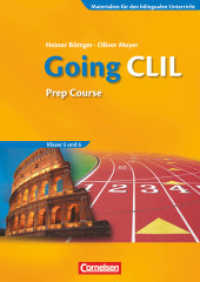Full Description
This book offers readers a plethora of activities for teaching the five components of a good reading program: phonemic awareness, phonics, vocabulary, fluency, and comprehension. Unlike other books that describe a series of activities without any clear point, each chapter in this book explains how activities contribute to fluent reading. New and practicing teachers will find an overview of what each component looks like from a classroom perspective with suggestions for informal assessment. Also included are best practices for teaching each of the five components, best practices for teaching English language learners, and best practices for working with struggling readers. The book is full of citations from professional literature, which makes it appropriate for teachers who are expected to make instructional choices based on research evidence. FEATURES: Describes how phonemic awareness, phonics and vocabulary contribute to fluency, and how automatic word recognition and fluency contribute to comprehension-Gives the reader a clear conceptual framework for implementing classroom practices.Offers a plethora of easy-to-implement teaching appropriate for children in classrooms from kindergarten through fifth grade-The wide range of activities makes this book a useful resource for preservice teachers who do not know the grade they will teach and inservice teachers in graduate courses or in the classroom, as well as for coaches (or mentors) in the elementary school.Boxed features describing best practices for teaching (1) the major components of reading, (2) English language learners and (3) struggling readers-Best practices give the reader guidance for improving classroom practices specifically tailored to teaching each component, English learners and struggling readers.Informal assessments in each chapter-Suggestions for informal assessments provide classroom-appropriate methods that can be used for formative and summative evaluations of student learning.Activities give the reader advice on grouping, provide a list of material, and include step-by-step directions-Clear, reader friendly explanations give the reader all the information needed to implement activities, thereby making it easier for the reader to use activities in the classroom.
Contents
Chapter 1 - Phonemic AwarenessPhonemic Awareness Contributes to VocabularyRhyme Awareness and Phonemic Awareness17 Activities to Develop Rhyme Awareness, Beginning Sound Awareness, Segmenting, and BlendingInformal Assessment or Additional Practices for Observing and Developing Phonemic AwarenessPhonemic Awareness in the Classroom Chapter 2 - PhonicsPhonics Contribute to Vocabulary and FluencyLetter-Sound Patterns17 Activities to Develop DecodingInformal Assessment or Additional Practices for Observing and Developing Good DecodersPhonics in the ClassroomChapter 3 - Decoding with Structural AnalysisStructural Analysis Contributes to Vocabulary and FluencyThe Structure of Complex Words17 Activities to Develop Decoding with Structural AnalysisInformal Assessment or Additional Practices for Observing and Developing Decoding with Structural AnalysisStructural Analysis in the ClassroomChapter 4 - Meaning VocabularyVocabulary Makes Fluent Reading and Comprehension PossibleThe Words That Matter the Most16 Activities to Develop Meaning VocabularyInformal Assessment or Additional Practices for Observing and Developing VocabularyVocabulary in the ClassroomChapter 5 - Oral Reading FluencyFluency Contributes to ComprehensionText That Makes It Easier to Develop Fluency17 Activities to Develop Oral Reading FluencyInformal Assessment or Additional Practices for Developing Oral Reading FluencyFluency in the Classroom Chapter 6 - ComprehensionFluent Reading Opens the Door to ComprehensionComprehension Strategies16 Activities to Develop ComprehensionInformal Assessment or Additional Practices for Observing and Developing ComprehensionComprehension in the Classroom








